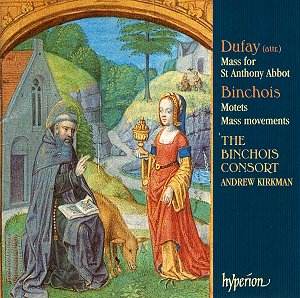Saint Anthony Abbot
("of Vienne") is the inspiration
for two of the works on this recently
recorded disc. This Saint Anthony (not
to be confused with Saint Anthony of
Padua) is well-known as one of the Egyptian
desert fathers, a hermit and contemplative
living in the third and fourth centuries
AD. Although he never founded an order,
he came to be one of the forefathers
of Western monasticism, whose relics,
moved to their final resting place near
Vienne, were said to have miraculous
healing powers.
The first work is a
ten-movement plenary mass, an anonymous
Missa Beati Anthonii which was
discovered in a group of fifteenth century
codices in Trent in Northern Italy.
The manuscript corresponds in its exact
combination of texts and melodies for
the Proper to those found apparently
exclusively in the chant books of the
chapel of St. Stephen in Cambrai Cathedral,
where Dufay had both trained and was
later canon. This gives rise to the
exciting speculation that it is the
second of two Saint Anthony Masses (the
first being for Saint Anthony of Padua)
bequeathed in his will to the cathedral
by Dufay, neither of which survived.
The three-voice mass, here reconstructed
by Alejandro Planchart, celebrates the
feast of St. Anthony on 17th
January, and is presented as it would
have been sung at Cambrai Cathedral
in the last decades of the fifteenth
century. Although certainly the influence,
at least, of Dufay rings out clearly
and recognisable, there are a few sections
that are less obviously marked with
Dufay’s voice. The sleeve-notes, although
leaving us to decide for ourselves whether
it is indeed Dufay’s work or that of
a skilled pupil, exhort us to bear in
mind the fact that we are not so familiar
with his later three-voice style. Although
it is generally assumed that Dufay had
moved on to a four-voice style in his
later works, both the Anthony Masses
and the lost Requiem were written in
a three-part texture, which, ever the
craftsman, no doubt he had developed
and elaborated in his own way.
The other Saint Anthony
work on this disc is Binchois’s Nove
cantum melodie, composed for the
baptism of the Duke of Burgundy’s son
in 1431, Saint Anthony being the child’s
name-saint. The two missing voices from
the first section have here been reconstructed
by Philip Weller, allowing for a first
recording of the complete work. An isorhythmic
motet, this is deeply innovative and
brilliantly crafted, creating music
that is driven and flowing despite its
rigid rhythmic structures.
Binchois fills the
rest of the disc with his motet, Domitor
Hectoris, whose text speaks of the
Cross and Holy Lance, with symbolic
reference to the healing of Telephus
of Troy, who was wounded by Achilles
and Adam ("The First Parent"),
and three mass movements, a Kyrie, Sanctus
and Agnus Dei. These are simpler pieces
than the other Binchois works featured
here but are still deeply lyrical and
moving. I personally like the touch
of taking the Kyrie faster than would
possibly be considered normal – it gives
greater animation and vivacity to a
wonderful movement.
These gorgeous works
are outstandingly performed by The Binchois
Consort under Andrew Kirkman (who have
also recorded the Dufay Saint Anthony
of Padua Mass - found in the Trent codices
around twenty years earlier - for Hyperion).
They combine exquisite voice control
with perfect intonation to create wonderfully
fluid, sustained lines, and an apt air
of reverence, ceremony and awe, without
being at all stuffy – a breath of fresh
air!
This is music that
one can lose oneself in. Often searingly
beautiful, often surprisingly inventive,
and always brilliantly performed; music
that is good for both ear and soul.
Em Marshall







